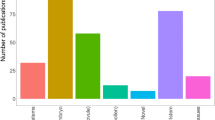Abstract
Perennial ryegrass (Lolium perenne L.) is the most important grass species in areas with a temperate climate. Biolistic transfer of a ubiquitin promoter driven nptII expression cassette into mature or immature tissue derived calli of perennial ryegrass followed by paromomycin selection, resulted in the rapid and efficient production of fertile transgenic ryegrass plants. Transformation efficiencies after paromomycin selection in combination with the nptII selectable marker compared favourably with hygromycin selection in combination with the hph selectable marker. In total 83 independent nptII expressing plants were produced. Transformation frequency was highly affected by genotype, explant, selection regime and the duration of the callus induction period. The optimised transformation protocol for mature embryo derived calli of turf-type or forage-type cultivars resulted in an average transformation efficiency of 5.2% or 6.6% respectively. This converts into 1.7 or 2.2 independent transgenic plants per bombardment. Immature inflorescence- and immature embryo-derived calli were also successfully used as target for the gene transfer, resulting in transformation efficiencies of up to 3.7% or 11.42% respectively. Transgenic plants were transferred to soil 12 or 9 weeks after excision of mature and immature embryos or inflorescences respectively. Transgene integration and expression were confirmed by PCR and ELISA or western blot analysis. Southern blot analysis confirmed the independent nature of the transgenic lines. The majority of lines showed the integration of two to six transgene copies, while 21% of the analysed lines had a single copy insert. A short tissue culture period in comparison to recently published reports seems to be beneficial for the production of normal and fertile transgenic ryegrass plants. Consequently we report for the first time molecular evidence for sexual transgene transmission in fertile transgenic perennial ryegrass.
Similar content being viewed by others
References
Altpeter F. and Posselt U.K. 2000. Improved plant regeneration from cell suspensions of commercial cultivars, breedingand inbred lines of perennial ryegrass (Lolium perenne L.). J. Plant Physiol. 156: 790–796.
Altpeter F., Vasil V., Srivastava V., Stoeger E. and Vasil I.K. 1996. Accelerated production of transgenic wheat plants. Plant Cell Rep. 16: 12–17.
Christensen A.H. and Quail P.H. 1996. Ubiquitin promoterbased vectors for high-level expression of selectable and/or screenable marker genes in monocotyledonous plants. Transgen. Res. 5: 213–218.
Creemers-Molenaar J. and Loeffen J.P.M. 1991. Regeneration from protoplasts of perennial ryegrass; progress and applications. In: den Nijs J.P.M. and Elgersma A. (eds.), Fodder Crops Breeding: Achievements, Novel Strategies and Biotechnology. Proceedings of the 16th meeting of the Fodder crops section of Eucarpia (16-22 November 1990,Wageningen, The Netherlands), pp. 123-128.
Dalton S.J., Bettany A.J.E., Timms E. and Morris P, 1998. Transgenic plants of Lolium multiflorum, Lolium perenne, Festuca arundinacea and Agrostis stolonifera by silicon carbide fibre-mediated transformation of cell suspension cultures. Plant Sci. 132: 31–43.
Dalton S.J., Bettany A.J.E., Timms E. and Morris P. 1999. Cotransformed, diploid Lolium perenne (perennial ryegrass), Lolium multiflorum (Italian ryegrass) and Lolium temulentum (darnel) plants produced by microprojectile bombardment. Plant Cell Rep 18: 721–726.
Datta S.K., Peterhans A., Datta K. and Potrykus I. 1990. Genetically engineered fertile indica-rice recovered from protoplasts. Bio/technology 8: 736–740.
Deambrogio E. and Dale P.J. 1980. Effect of 2,4-D on the frequency of regenerated plants in barley and on genetic variability between them. Cearch Res Comm. 8: 417–423.
Dellaporta S.L., Wood J. and Hicks J.B. 1983. A plant DNA minipreparation: Version II. Plant Mol. Biol. Rep. 4: 19–21.
EC. 1999. Standing Group on Seeds of the Advisory Committee on Agricultural Products, Health and Safety, 28 April 1999, EU, Brussels, Belgium.
Hajdukiewicz P., Svab Z. and Maliga P. 1994. The small, versatile pPZP family of agrobacterium binary vectors for plant transformation. Plant Mol. Biol. 25: 989–994.
Jung G.A., van Wijk A.J.P., Hunt W.F. and Watson C.E. 1996. Ryegrasses. In: Moser L.E., Buxton D.R. and Casler M.D. (eds.), Cool-Season Forage Grasses, Madison Wisconsin USA Publishers, Madison, WI, pp. 605–641.
Murashige T. and Skoog F. 1962. A revised medium for rapid growth and bioassays with tobacco tissue cultures. Physiol. Plant. 15: 473–497.
Murata M. 1989. Effect of auxin and cytokinin on induction of sister chromatid exchanges in cultured cells of wheat (Triticum aestivum L.). Theor. Appl. Genet. 78: 521–524.
Sanford J.C., de Vit M.J., Russel J.A., Smith F.D., Harpending P.R., Roy M.K. and Johnson S.A. 1991. An improved, heliumdriven biolistic device. Technique 3: 3–16.
Spangenberg G., Wang Z.-Y., Wu X.L., Nagel J. and Potrykus I. 1995. Transgenic perennial ryegrass (Lolium perenne) plants from microprojectile bombardment of embryogenic suspension cells. Plant Sci. 108: 209–217.
Spangenberg G., Wang Z.-Y., Ye X.D., Wu X.L. and Potrykus I. 2000. Transgenic ryegrasses (Lolium spp.). In: Bajaj Y.P.S. (ed.), Biotechnology in Agriculture and Forestry, Vol. 46: Transgenic crops I, Springer, Berlin/Heidelberg, Germany. pp. 172–187.
Wang G.R., Binding H. and Posselt U.K. 1997. Fertile transgenic plants from direct gene transfer to protoplasts of Lolium perenne L. and Lolium multiflorum Lam. J. Plant Physiol. 151: 83–90.
Author information
Authors and Affiliations
Rights and permissions
About this article
Cite this article
Altpeter, F., Xu, J. & Ahmed, S. Generation of large numbers of independently transformed fertile perennial ryegrass (Lolium perenne L.) plants of forage- and turf-type cultivars. Molecular Breeding 6, 519–528 (2000). https://doi.org/10.1023/A:1026589804034
Issue Date:
DOI: https://doi.org/10.1023/A:1026589804034




